Performance Investigation on Different Designs of Superhydrophobic Surface Texture for Composite Insulator
Abstract
:1. Introduction
2. Experimental Section
2.1. Preparation of the Samples
2.2. Design of Surface Texture
2.3. Surface Performance Tests
2.3.1. Corrosion Test
2.3.2. Contamination Test
2.3.3. Wear Test
2.3.4. Droplets Falling Test
3. Results and Discussion
3.1. Hydrophobicity of Different Textured Surfaces
3.2. Corrosion Resistance
3.3. Self-Cleaning Antifouling Performance
3.4. Abrasion Resistance
3.5. Droplet Rolling Performance on Textured Surfaces
4. Conclusions
Author Contributions
Funding
Conflicts of Interest
References
- Zhang, P.; Lv, F.Y. A review of the recent advances in superhydrophobic surfaces and the emerging energy-related applications. Energy 2015, 82, 1068–1087. [Google Scholar] [CrossRef]
- Milionis, A.; Loth, E.; Bayer, I.S. Recent advances in the mechanical durability of superhydrophobic materials. Adv. Colloid Interface Sci. 2016, 229, 57–79. [Google Scholar] [CrossRef] [PubMed]
- Guo, Z.G.; Liu, W.M.; Su, B.L. Superhydrophobic surfaces: From natural to biomimetic to functional. J. Colloid Interface Sci. 2011, 353, 335–355. [Google Scholar] [CrossRef]
- Pan, S.; Kota, A.; Mabry, J.; Tuteja, A. Superomniphobic surfaces for effective chemical shielding. J. Am. Chem. Soc. 2013, 135, 578–581. [Google Scholar] [CrossRef]
- Fihri, A.; Bovero, E.; Shahrani, A.A.; Ghamdi, A.A.; Alabedi, G. Recent progress in superhydrophobic coatings used for steel protection: A review. Colloids Surf. A 2017, 520, 378–390. [Google Scholar] [CrossRef]
- Yan, Y.Y.; Gao, N.; Barthlott, W. Mimicking natural superhydrophobic surfaces and grasping the wetting process: A review on recent progress in preparing superhydrophobic surfaces. Adv. Colloid Interface Sci. 2011, 169, 80–105. [Google Scholar] [CrossRef]
- Zhang, C.Q.; Mcadams, D.A., II; Grunlan, J.C. Nano/Micro-Manufacturing of Bioinspired Materials: A Review of Methods to Mimic Natural Structures. Adv. Mater. 2016, 28, 6292–6321. [Google Scholar] [CrossRef] [PubMed]
- Soz, C.K.; Yilgor, E.; Yilgor, I. Simple processes for the preparation of superhydrophobic polymer surfaces. Polymer 2016, 99, 580–593. [Google Scholar] [CrossRef]
- Si, Y.F.; Guo, Z.G. Superhydrophobic nanocoatings: From materials to fabrications and to applications. Nanoscale 2015, 7, 5922–5946. [Google Scholar] [CrossRef]
- Shit, S.C.; Shah, P. A Review on Silicone Rubber. Natl. Acad. Sci. Lett. 2013, 36, 355–365. [Google Scholar] [CrossRef]
- Xu, Z.; Zhang, F.Z.; Zhang, H.; Zhang, G.F.; Chen, J.J.; Tu, Y.P. Investigation of the aging of line composite insulator sheds. ICHVE 2012, 489–491. [Google Scholar] [CrossRef]
- Yang, Z.X.; Jia, Z.D.; Chen, C.; Zhang, X.D.; Liu, L.; Zhu, R.G.; Xie, Q. Hydrophobicity distribution analysis of DC composite insulators. EIC 2014, 465–468. [Google Scholar] [CrossRef]
- Swift, D.A.; Spellman, C.; Haddad, A. Hydrophobicity transfer from silicone rubber to adhering pollutants and its effect on insulator performance. IEEE Trans. Dielectr. Electr. Insul. 2006, 13, 820–829. [Google Scholar] [CrossRef]
- Cao, L.; Jones, A.K.; Sikka, V.K.; Wu, J.; Gao, D. Anti-icing superhydrophobic coatings. Langmuir 2009, 25, 12444–12448. [Google Scholar] [CrossRef]
- Farhadi, S.; Farzane, M.H.; Kulinich, S.A. Anti-icing performance of superhydrophobic surfaces. Appl. Surf. Sci. 2011, 257, 6264–6269. [Google Scholar] [CrossRef]
- Vazirinasab, E.; Jafari, R.; Momen, G. Application of superhydrophobic coatings as a corrosion barrier: A review. Surf. Coat. Technol. 2018, 341, 40–56. [Google Scholar] [CrossRef]
- Si, Y.F.; Guo, Z.G.; Liu, W.M. A robust epoxy resins @ stearic acid-Mg(OH)2 micronanosheet superhydrophobic omnipotent protective coating for real-life applications. ACS Appl. Mater. Interfaces 2016, 25, 16511–16520. [Google Scholar] [CrossRef]
- Peng, W.Y.; Gou, X.L.; Qin, H.L.; Zhao, M.Y.; Zhao, X.Z.; Guo, Z.G. Creation of a multifunctional superhydrophobic coating for composite insulators. Chem. Eng. J. 2018, 352, 774–781. [Google Scholar] [CrossRef]
- Yang, Y.; Sun, X.C.; Li, J.; Hu, J.L. The preparation and study of a superhydrophobic icing preventing coating. Insul. Surge Arresters. 2012, 2, 25–30. (In Chinese) [Google Scholar]
- Momen, G.; Farzaneh, M. Survey of micro/nano filler use to improve silicone rubber for outdoor insulators. Rev. Adv. Mater. Sci. 2011, 27, 1–13. [Google Scholar]
- Li, J.; Fan, L.; Wong, C. Insulator Coating and Method for Forming Same. U.S. Patent 7,722,951 B2, 25 May 2010. [Google Scholar]
- Li, J.; Zhao, Y.S.; Hu, J.L.; Shu, L.C.; Shi, X.M. Anti-icing Performance of a Superhydrophobic PDMS/Modified Nano-silica Hybrid Coating for Insulators. J. Adhes. Sci. Technol. 2012, 26, 665–679. [Google Scholar] [CrossRef]
- Janjua, Z.A.; Turnbull, B.; Choy, K.L.; Pandis, C.; Liu, J.; Hou, X.H.; Choi, K.S. Performance and durability tests of smart icephobic coatings to reduce ice adhesion. Appl. Surf. Sci. 2017, 407, 555–564. [Google Scholar] [CrossRef]
- Mohamed, A.M.A.; Abdullah, A.M.; Younan, N.A. Corrosion behavior of superhydrophobic surfaces: A review. Arabian J. Chem. 2015, 8, 749–765. [Google Scholar] [CrossRef]
- Chen, K.; Wang, Q.; Sun, T.; You, M.; Xia, Z.X. Research on impact of chemical etching on superhydrophobic surface property. New Chem. Mater. 2018, 46, 206–209. [Google Scholar]
- Cohen, N.; Dotan, A.; Dodiuk, H.; Kenig, S. Superhydrophobic Coatings and Their Durability. Mater. Manuf. Process. 2016, 31, 1143–1155. [Google Scholar] [CrossRef]
- Golovin, K.; Kobaku, S.P.R.; Lee, D.H.; DiLoreto, E.T.; Mabry, J.M.; Tuteja, A. Designing durable icephobic surfaces. Sci. Adv. 2016, 2. [Google Scholar] [CrossRef]
- Wang, Y.; Yao, X.; Chen, J.; He, Z.; Liu, J.; Li, Q.; Wang, J.; Jiang, L. Organogel as durable anti-icing coatings. Sci. China Mater. 2015, 58, 559–565. [Google Scholar] [CrossRef]
- Zhang, X.; Si, Y.F.; Mo, J.L.; Guo, Z.G. Robust micro-nanoscale flowerlike ZnO/epoxy resin superhydrophobic coating with rapid healing ability. Chem. Eng. J. 2017, 313, 1152–1159. [Google Scholar] [CrossRef]
- Mortazavi, V.; Khonsari, M.M. On the degradation of superhydrophobic surfaces: A review. Wear 2017, 372–373, 145–157. [Google Scholar] [CrossRef]
- Chen, J.; Liu, J.; He, M.; Li, K.; Cui, D.; Zhang, Q.; Zeng, X.; Zhang, Y.; Wang, J.; Song, Y. Superhydrophobic surfaces cannot reduce ice adhesion. Appl. Phys. Lett. 2012, 101, 111603. [Google Scholar] [CrossRef]
- Jung, S.; Dorrestijn, M.; Raps, D.; Das, A.; Megaridis, C.M.; Poulikakos, D. Are superhydrophobic surfaces best for icephobicity? Langmuir 2011, 27, 3059–3066. [Google Scholar] [CrossRef]
- Kulinich, S.A.; Farhadi, S.; Nose, K.; Du, X.W. Superhydrophobic surfaces: Are they really ice-repellent? Langmuir 2011, 27, 25–29. [Google Scholar] [CrossRef]
- Groenendijk, M. Fabrication of Super Hydrophobic Surfaces by fs Laser Pulse. Laser Technol. 2008, 5, 44–47. [Google Scholar] [CrossRef]
- Ahmmed, K.M.T.; Kietzig, A.M. Drag reduction on laser-patterned hierarchical superhydrophobic surfaces. Soft Matter 2016, 12, 4912–4922. [Google Scholar] [CrossRef]
- Kietzig, A.M.; Hatzikiriakos, S.G.; Englezos, P. Patterned Superhydrophobic Metallic Surfaces. Langmuir 2009, 25, 4821–4827. [Google Scholar] [CrossRef]
- Ta, D.V.; Dunn, A.; Wasley, T.J.; Kay, R.W.; Stringer, J.; Smith, P.J.; Connaughton, C.; Shephard, J.D. Nanosecond laser textured superhydrophobic metallic surfaces and their chemical sensing applications. Appl. Surf. Sci. 2015, 357, 248–254. [Google Scholar] [CrossRef]
- Ta, V.D.; Dunn, A.; Wasley, T.J.; Li, J.; Kay, R.W.; Stringer, J.; Smith, P.J.; Esenturk, E.; Connaughton, C.; Shephard, J.D. Laser textured superhydrophobic surfaces and into their applications for homogeneous spot deposition. Appl. Surf. Sci. 2016. [Google Scholar] [CrossRef]
- Wu, B.; Zhou, M.; Li, J.; Ye, X.; Li, G.; Cai, L. Superhydrophobic surfaces fabricated by microstructuring of stainless steel using a femtosecond laser. Appl. Surf. Sci. 2009, 256, 61–66. [Google Scholar] [CrossRef]
- Bizi-Bandoki, P.; Benayoun, S.; Valette, S.; Beaugiraud, B.; Audouard, E. Modifications of roughness and wettability properties of metals induced by femtosecond laser treatment. Appl. Surf. Sci. 2011, 257, 5213–5218. [Google Scholar] [CrossRef]
- Cunha, A.; Serro, A.P.; Oliveira, V.; Almeida, A.; Vilar, R.; Durrieu, M.C. Wetting behaviour of femtosecond laser textured Ti-6Al-4V surfaces. Appl. Surf. Sci. 2013, 265, 688–696. [Google Scholar] [CrossRef]
- Li, Q.F.; Fan, Z.; Wu, Q.; Gao, J.; Su, Z.Y.; Zhou, W.J. Investigation of ice-covered transmission lines and analysis on transmission line failures caused by ice-coating in China. Power Syst. Technol. 2008, 32, 33–36. [Google Scholar]
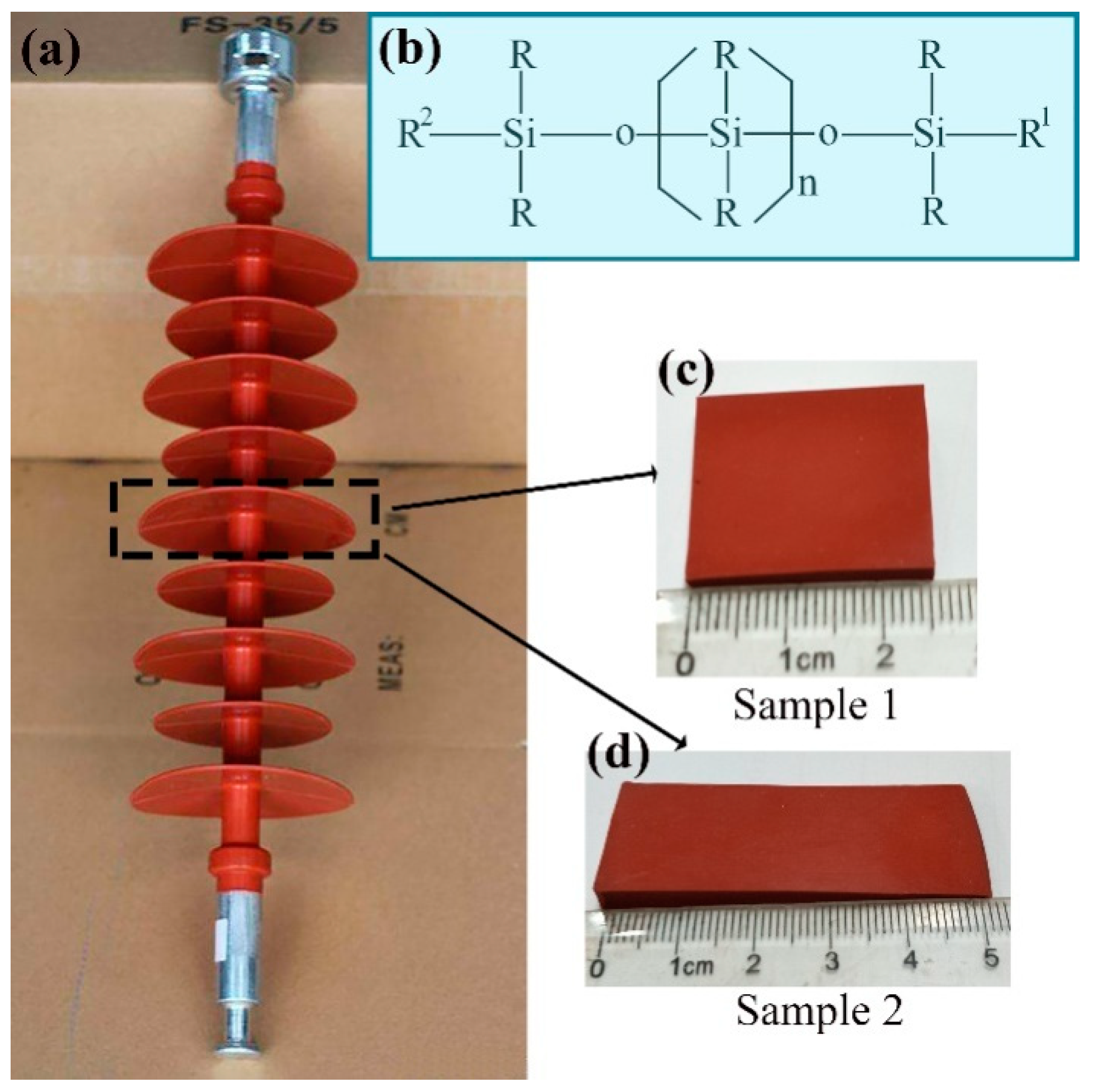
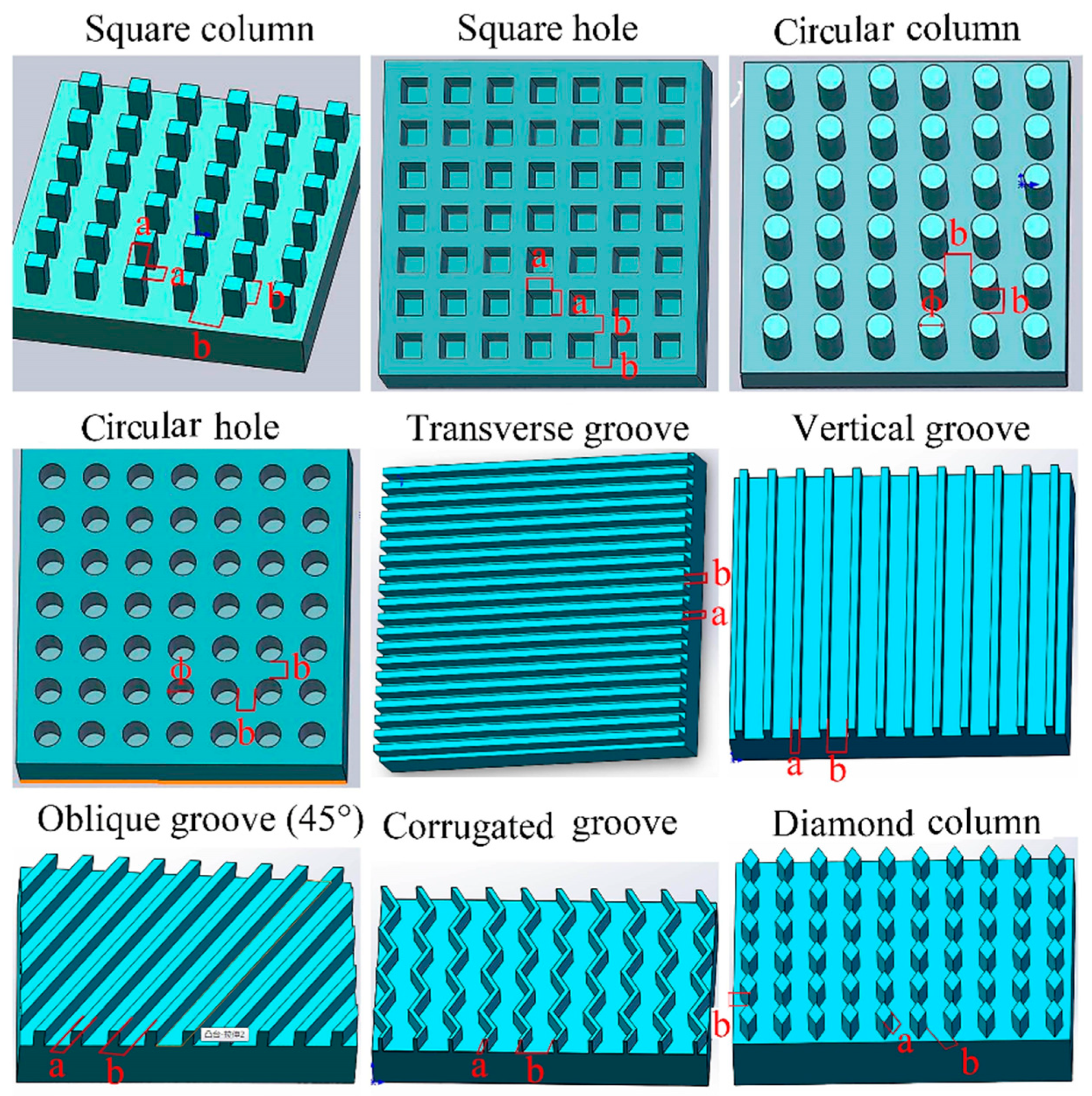
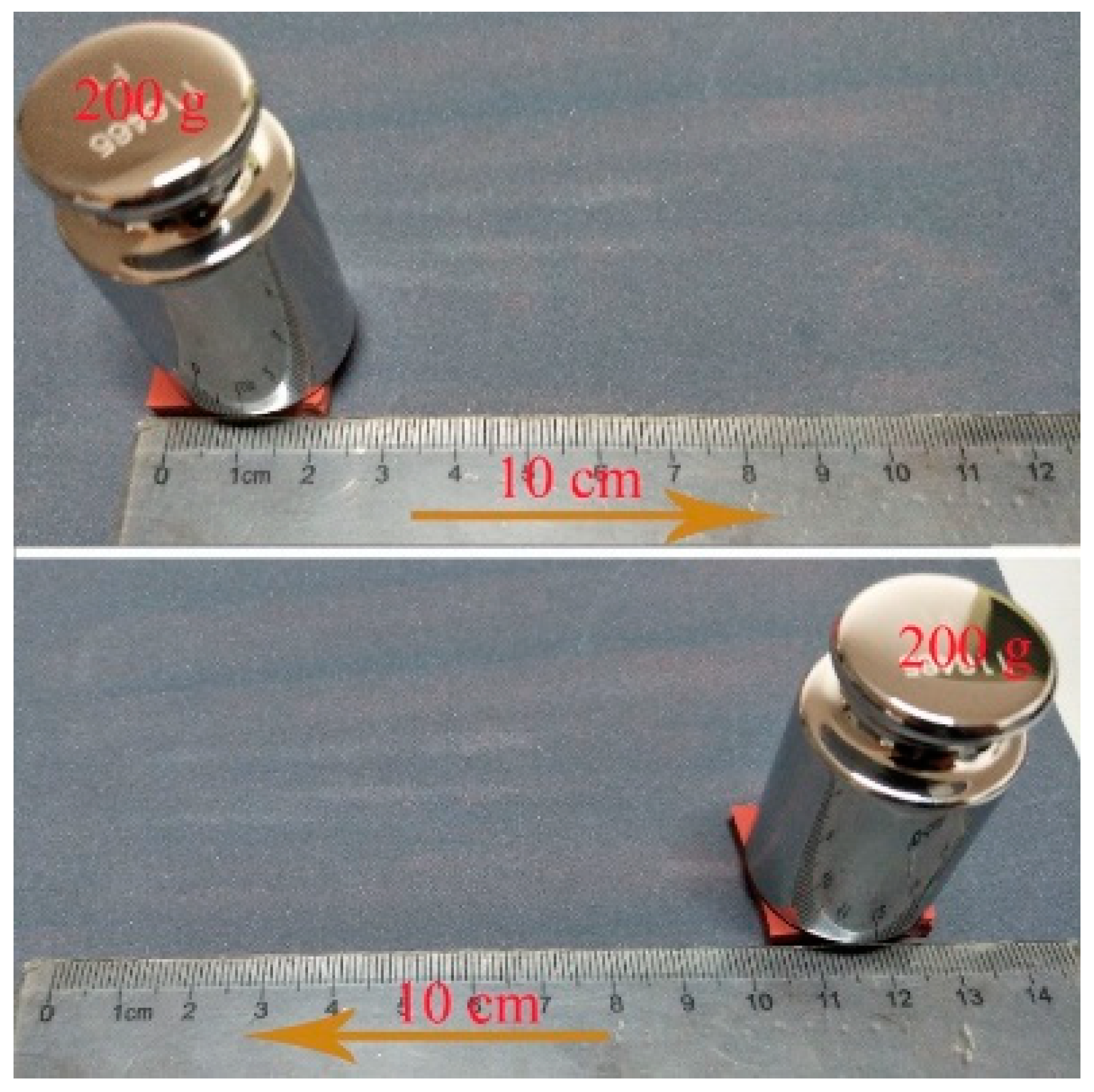
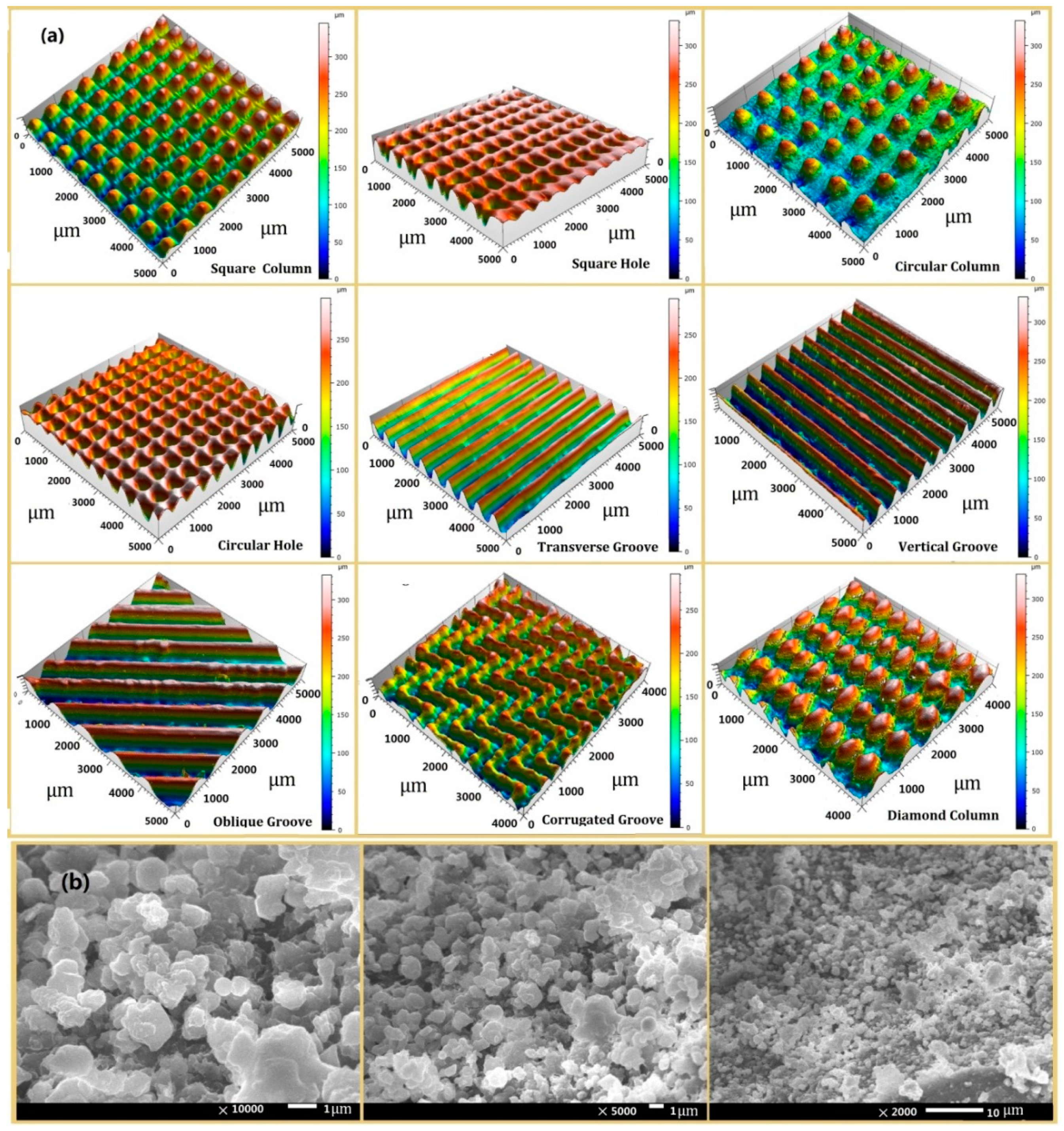

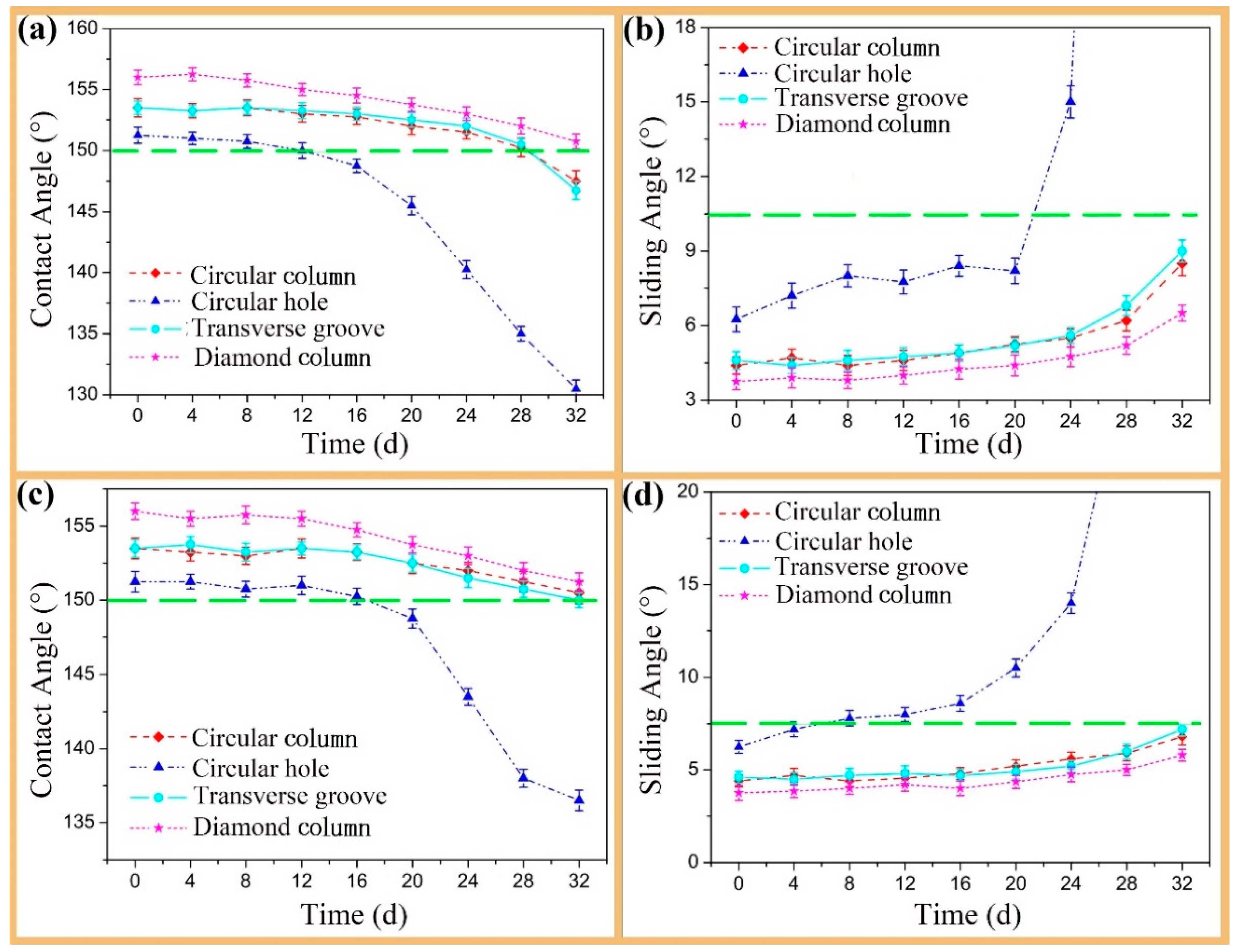

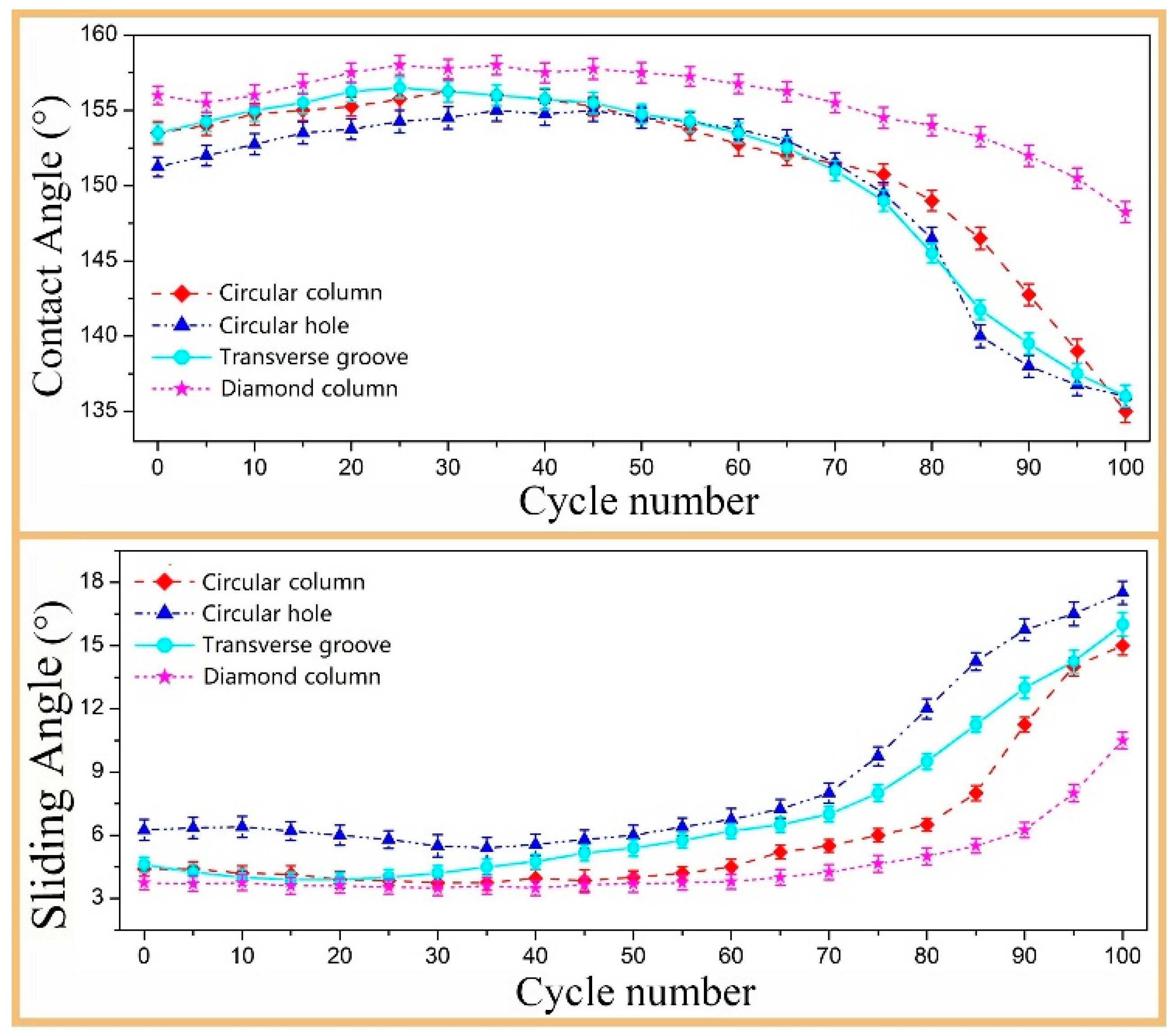

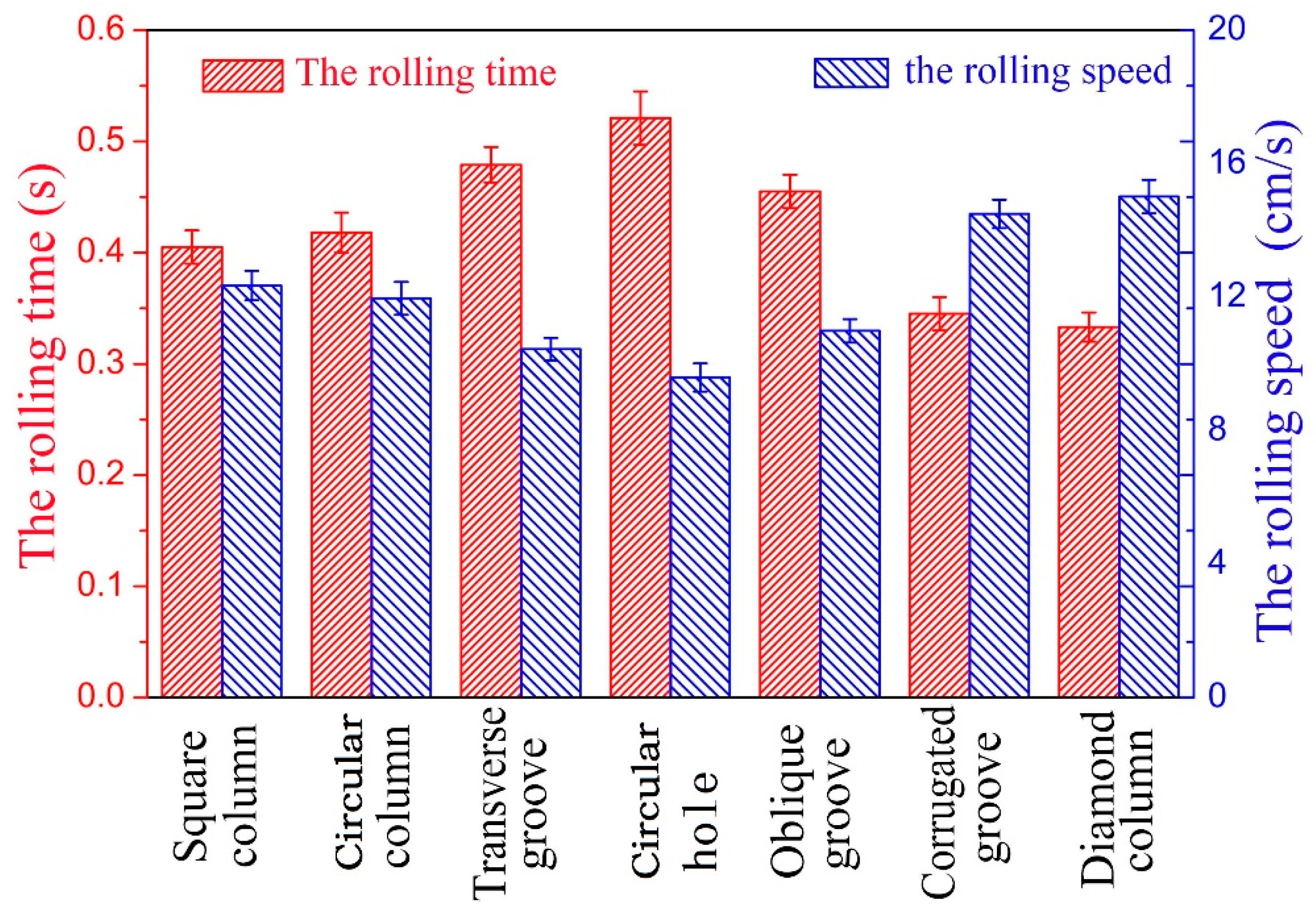
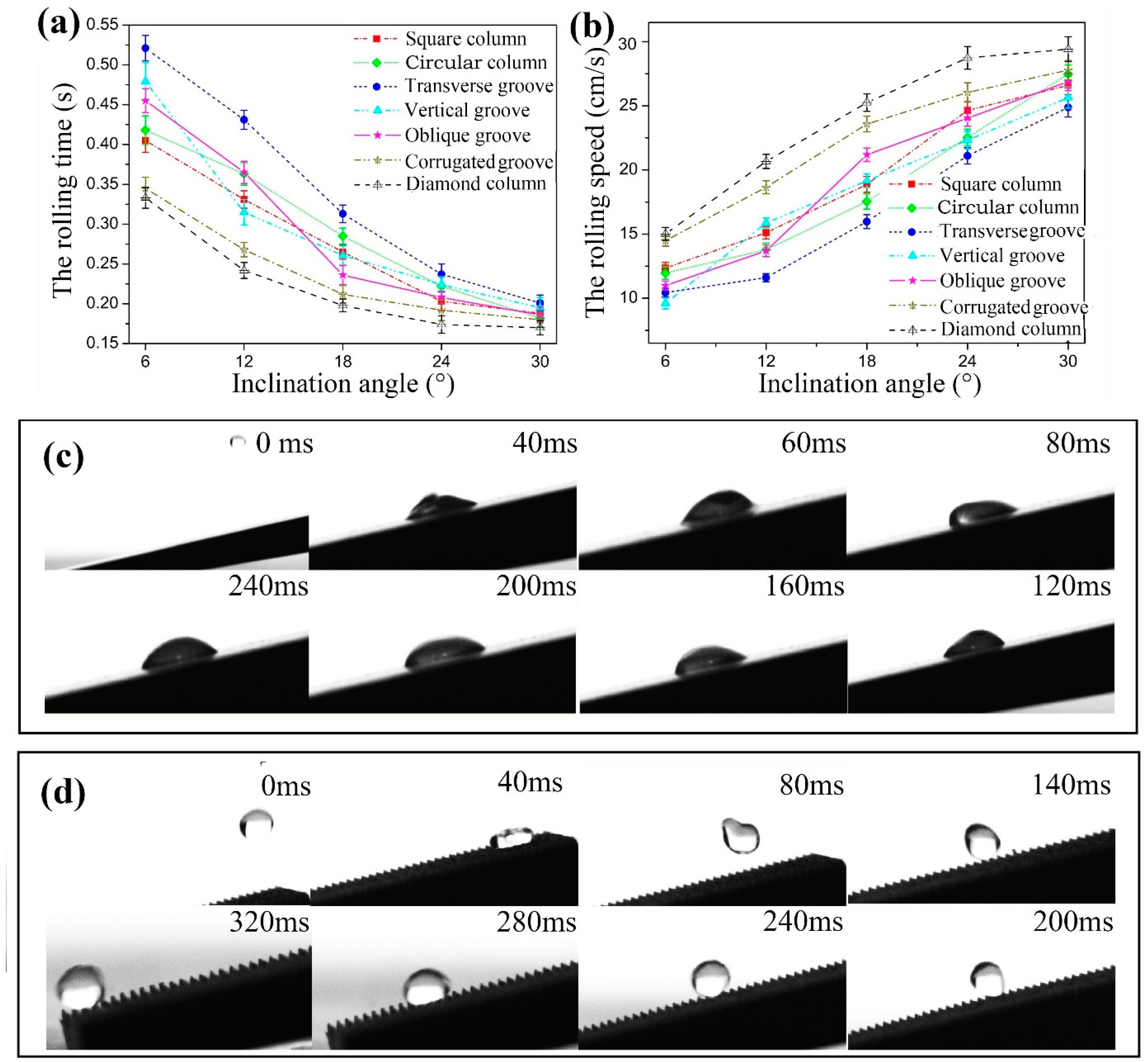

| Texture Designs | SC | SH | CC | CH | TG | VS | OG | CG | DC | |
| Contact Angle (CA) | 154° | 152° | 153.5° | 151.25° | 153.5° | 153° | 154° | 155° | 156° | |
| Sliding Angle (SA) | 4.3° | 6.5° | 4.4° | 6.25° | 4.6° | 5.25° | 4.35° | 4° | 3.75° | |
| Optimal Parameters | P/w | 35 for all | ||||||||
| a/ | 300 | 300 | 400 | 400 | 300 | 300 | 300 | 200 | 300 | |
| b/ | 400 | 200 | 300 | 200 | 300 | 300 | 300 | 300 | 400 | |
| Texture Design | SC | CC | TG | VG | OG | CG | DC |
|---|---|---|---|---|---|---|---|
| Rolling Time/s | 0.402 | 0.418 | 0.479 | 0.521 | 0.455 | 0.345 | 0.333 |
| Measuring Error/s | 0.015 | 0.018 | 0.016 | 0.024 | 0.015 | 0.014 | 0.013 |
© 2019 by the authors. Licensee MDPI, Basel, Switzerland. This article is an open access article distributed under the terms and conditions of the Creative Commons Attribution (CC BY) license (http://creativecommons.org/licenses/by/4.0/).
Share and Cite
Zhao, M.; Li, W.; Wu, Y.; Zhao, X.; Tan, M.; Xing, J. Performance Investigation on Different Designs of Superhydrophobic Surface Texture for Composite Insulator. Materials 2019, 12, 1164. https://doi.org/10.3390/ma12071164
Zhao M, Li W, Wu Y, Zhao X, Tan M, Xing J. Performance Investigation on Different Designs of Superhydrophobic Surface Texture for Composite Insulator. Materials. 2019; 12(7):1164. https://doi.org/10.3390/ma12071164
Chicago/Turabian StyleZhao, Meiyun, Wei Li, Yang Wu, Xinze Zhao, Mingyi Tan, and Jingtang Xing. 2019. "Performance Investigation on Different Designs of Superhydrophobic Surface Texture for Composite Insulator" Materials 12, no. 7: 1164. https://doi.org/10.3390/ma12071164






